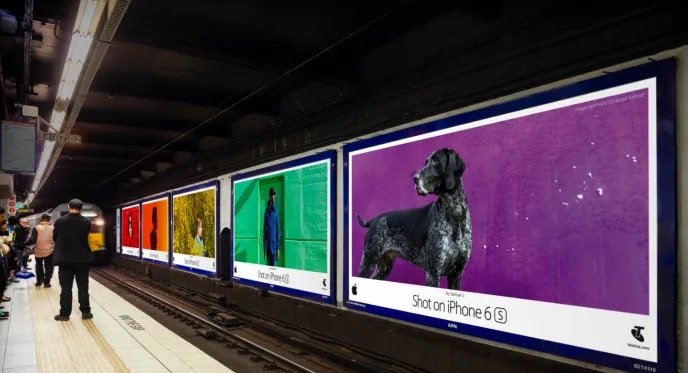Selfies, Stadiums, and Storytelling—Apple’s Camera Roll of Influence
By Ethan Chandler
Image courtesy: Medium
We’re all about the deals and features, right? But let’s be honest–what’s actually in it for you?
Brands love to shout about their latest offerings, but they often forget to listen amid all the noise. Too much focus on pushing sales, not enough on crafting an authentic relationship with you–the consumer. This lack of connection leads to getting lost in a sea of ads, all while missing the opportunity to carve out a unique identity. Developing a deeper understanding of consumer needs allows brands to effectively tap into our point of view—resulting in higher-level work that actually speaks to us.
But there’s one brand that does things differently. Take a guess. If you said orange, you’re not far off…Apple.
Powered by Pixels, Driven by Vision
From the classic “1984” ad to the unforgettable “Silhouette” campaign of 2003, Apple has never just been about selling tech. They’ve crafted a feeling. Instead of selling us on the latest iPhone or iPad, Apple highlights the creativity, imagination, and defiance that sets them apart.
But, of course, even Apple isn’t immune to a few bumps in the road. Or, in the iPhone 6’s case, a bend. Suddenly, even the most loyal Apple fans were raising their eyebrows, questioning the company’s innovation. So how did Apple bounce back from a very public “whoops?” Let’s take a look.
The Mic is On, and the Spotlight is Yours
Apple responded by letting their customers—ranging from industry professionals to aspiring creatives—do the talking. In March 2015, TBWA\Media Arts Lab launched the #ShotOniPhone campaign, inviting social media users to tag their stunning iPhone photos with the hashtag to be featured on Apple's website. The best submissions were showcased on billboards and in 15-second commercials, putting the spotlight exclusively on the iPhone’s impressive capabilities while reaching an impressive global audience. And guess what? It worked. Instead of just telling us about the iPhone 6’s camera, Apple let us see it in action. Breathtaking photographs from mountaintops, city streets, and oceans lit up billboards worldwide. Each piece was paired with the simple “Shot on iPhone” tagline, creating a seamless connection between the visuals and the brand. No fluff–just pure creativity and the power of user-generated content.
Image courtesy: The Exhibit Company
User-Generated Content: Limitless Creativity. One Upload Away
What makes Apple’s approach so unique? They never lose sight of the consumer imagination that lies at the heart of their brand. Apple encourages everyday people to participate in challenges, share their photos, and ultimately showcase the iPhone’s versatility. From underwater selfies to neon-lit photoshoots, Shot on iPhone continues to showcase how the iPhone adapts to every person’s identity and creative vision.
The brilliance of this campaign? Simplicity. The message was clear, but it didn’t feel forced. Its tagline did the heavy lifting, reminding us of the brand behind the beauty without being overly promotional.
And then there’s the authenticity–the secret sauce. The photos weren’t just high-quality shots; they were genuine, raw-burst expressions of creativity—a testament to the potential of both the iPhone camera and that of its users.
A Picturesque Campaign for Years to Come
#ShotoniPhone was a global success. With over 770 billboards appearing in 79 cities, Apple saw an increase of 62 million iPhones sold in 2015 and a $51 billion boost in revenue—no big deal (Business of Apps). The campaign even snagged the Outdoor Lions Grand Prix at the Cannes Lions International Festival of Creativity in June 2015.
Over a decade later, #ShotoniPhone is alive and well. There are over 31 million Instagram posts featuring the hashtag as of April 2025, truly showcasing the campaign’s longevity. And Apple continues to keep the magic alive through short films, event livestreams, and even The Weeknd’s “Dancing in the Flames.” These executions demonstrate that the iPhone is not just a mobile device but a means of capturing the special moments in our daily lives. This further engrains both Apple and the iPhone in pop culture while positioning the device as an extension of your imagination.
But here’s the rundown: As Apple keeps flexing their new features (hello telephoto lens and water resistance), the brand begins to blur the line between fiction and reality. Disclaimers like “professionally edited” and “additional hardware used” get in the way, leaving the once-authentic vibe feeling a bit staged. Apple must find balance between keeping it real and showcasing its tech to maintain the magic of #ShotoniPhone for years to come.
Image courtesy: Ads of the World
Not Everyone Can ‘Think Different’
Let’s be real for a second. Not every brand can pull off the Shot on iPhone magic. Apple is a household name, and people already know what it stands for. They don’t need to drown you in technical jargon because their brand identity is already clear. But for other brands, it's crucial to craft a message that speaks to the consumer’s perspective. It’s all about creating a relevant narrative that draws your audience in and leaves them saying, “Wow, I need that.”
More Than Loyalty, It’s Legacy
Ultimately, Apple’s Shot on iPhone campaign is a perfect example of how storytelling and user engagement can elevate a brand’s identity while driving real business results. It’s not just about the product; it’s about the experience, the creativity, and the connection with the audience.
So, what can other brands learn from Apple? Don’t just blast ads at people. Create a deeper story. Build a timeless narrative that resonates with your audience. Give them a reason to care and, most importantly, connect with them in a meaningful way.
Shot on iPhone has demonstrated that impactful storytelling starts with understanding. Know what makes your audience laugh, cry, and everything in between. Consumers will appreciate that you get them, providing your brand with a unique edge over the competition. So, consider taking a page out of Apple’s playbook, and approach your brand from your customers’ perspective. As terrifying as this sounds, it just might provide a gateway to an identity that resonates with them for years to come.



